
Once, when Krishna was preparing to go to Kurukshetra at the time of a solar eclipse, He invited the gopis (cowherd girls) and other residents of Vrindavan to meet Him at Kurukshetra. When He had left Vrindavan in His youth, He had promised to return very soon. But He had been away for a long time (about a hundred years), so out of intense spiritual love, the residents of Vrindavan had always felt ecstatic longing to see Him again. The residents of Dwaraka (a majestic city) arrived at Kurukshetra on chariots; the residents of Vrindavan (a simple cowherd village), on ox carts.
Accompanied by His brother, Balarama, and sister, Subhadra, and by other generals of the Yadu dynasty, Lord Krishna came to Kurukshetra for fasting and prayer during a full solar eclipse.
Arriving from His coastal kingdom of Dwaraka, He met with commanders of the Kuru dynasty, including Bhishma, Drona, Dhritarashtra, and Duryodhana, with the Pandavas, headed by King Yudhishthira, and with many other heads of state. The gathering of leaders, along with their wives and retinues, made for a magnificent religious, diplomatic, and social occasion. The Yadus and other dignitaries appeared in full-dress regalia, carrying their swords and other weapons. Kurukshetra resounded with the rumbling of ornate royal chariots drawn by powerful horses as graceful as ocean waves. Guests and celebrities made their entrances riding on great elephants that moved like clouds in the sky.
Though at home amid this splendor and pageantry, Lord Krishna had grown up among the gentle cowherd men and women of the village of Vrindavan. Political dangers had obliged Krishna father, Vasudeva, a Yadu prince, to place Krishna and Balarama from their births under the care of Vrindavan’s King Nanda. Nanda and his wife, Yashoda, raised Krishna and Balarama as their own children, and the two boys became the darlings not only of their foster parents but of the entire village. While Krishna roamed the forests and fields of Vrindavan during His youth, playing and tending cows with His cowherd boyfriends and Balarama, the hearts of everyone in Vrindavan went with Him. In particular, the young cowherd girls, or gopis, could not tolerate even a moment without seeing Krishna. When at an early age, Krishna reluctantly left Vrindadvan to take up princely duties, the gopis were devastated and longed day and night for His return. Hearing that Krishna would be at Kurukshetra for the solar eclipse, all Vrindavan prepared to go. Loading gifts and belongings on ox carts, the simple rural cowherd boys, girls, men, and women made their way north to the gala royal assembly. Religion and diplomacy were not high on their agenda. They wanted only to see Krishna and Balarama, their life and soul.
They arrived at Kurukshetra to a warm welcome from the Yadus, who were their intimate friends and relatives. Inquiring about each other’s well-being, everyone cried in jubilation while their smiling faces bloomed like lotus flowers. Both parties were great devotees of Krishna, and their talk turned around Him. The Yadus, despite their regal opulence and their participation in the lofty religious rituals at Kurukshetra, had no interest in wealth or piety. In all their duties and activities their sole object of devotion was Krishna. And as for the residents of Vrindavan, they circulated in the dazzling grandeur of the Kurukshetra assembly with eyes only for Krishna, their dear most cowherd boy.
Nanda and Yashoda’s affection for Krishna was so strong that despite hearing Krishna praised by the assembled kings as the omnipotent and omnipresent Supreme Lord, they could think of Him only as their little child. At the first opportunity, they took Krishna and Balarama aside to talk, placing the grown princes on their laps like eight-year-olds.
The gopis, though also not denying Krishna’s royalty or His position as the Supreme, were interested less than anyone in these trappings. They were overjoyed to see Krishna again, but the hubbub at Kurukshetra was a distraction. The crowds of people, along with horses, elephants, and the din of huge chariots moving here and there, left little room for intimacy. Krishna wore the formal attire of a prince and moved in the company of military officers. Drawing Krishna away from the crowds, the gopis requested Him to return with them to Vrindavan. Vrindavan was quiet, they pointed out, with beautiful streams and flower gardens. You could hear the buzzing of bees and the chirping of birds. Krishna wouldn’t need to dress up in all this finery or take part in all these ceremonious matters. In Vrindavan the gopis and Krishna could be alone together again.
Of all the residents of Vrindavan, the leading gopi, Srimati Radharani, had felt the pangs of separation from Krishna more than anyone else. “The gopis saw their beloved Krishna at Kurukshetra after a long separation. They secured and embraced Him in their hearts through their eyes, and they attained a joy so intense that not even perfect yogis can attain it. The gopis cursed the creator for creating eyelids that interfered with their vision." – Chaitanya-Charitamrita Adi-lila 4.153, & Srimad Bhagavatam Canto 10 Chapter 82
Though Krishna regretfully explained that He could not yet fulfill the gopi’s request, and although after a three-month visit with His dear childhood family and friends He returned to Dwaraka, the gopis forever aspired to have Him back. They longed to leave Kurukshetra with Krishna in tow on His grand royal chariot, pulling Him with them down the road to Vrindavan. She and the other gopis were determined to bring Krishna back to Vrindavan. The loving exchange between Krishna and the gopis at Kurukshetra is the esoteric meaning behind the festival known as Rathayatra (“Festival of the Chariots”). So whenever Hare Krishna devotees put on Rathayatras in cities around the world, they are proclaiming the glories of Kurukshetra.
Jyotisar
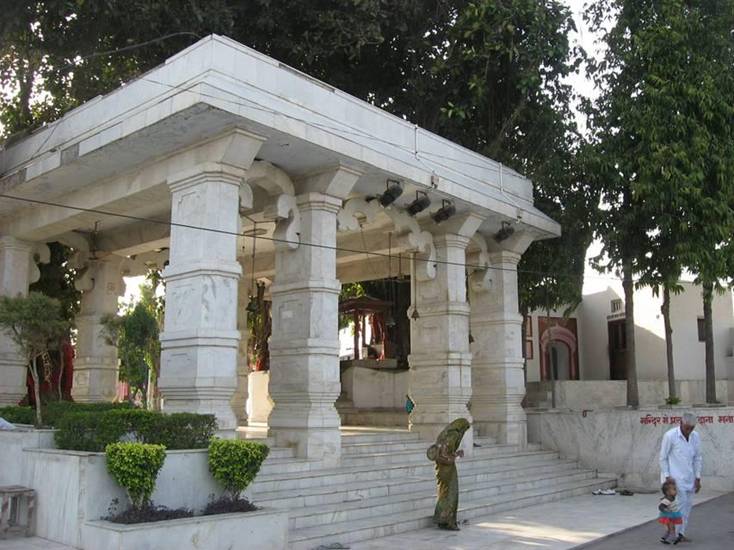
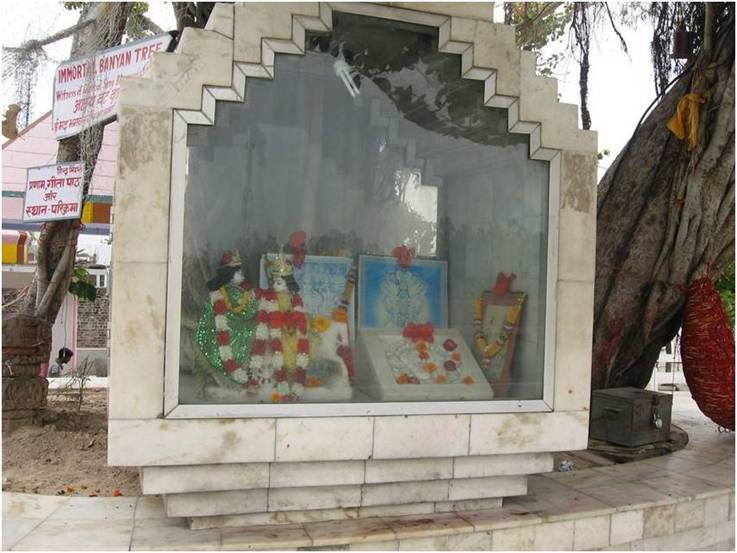
This is the exact spot where Lord Sri Krishna spoke Bhagavad-Gita. This the most important place to be seen in Kurukshetra because there is a Banyan tree in this place under which Krishna explained Bhagavad-Gita 5000 years back to Arjuna – his greatest friend and devotee. There is a board placed on the tree in which is written “The immortal banyan tree witness of the celestial song Bhagavad-Gita”. In fact this place is named as the “Gitopadesh sthal – place where the Bhagavad-Gita was spoken”. There is also a small chariot in a glass and marble case below the banyan tree where one can see Krishna and Arjuna speaking to each other. There is also another chariot nearby much bigger entirely in glass casing where both Krishna and Arjuna are seated. In the same courtyard of the Geethopadesh sthal is a Ved Pathshala, rooms containing different characters of Mahabharata like Ganga mata, Bhismadeva, Krishna-Arjuna etc… There is also an ancient Shiva temple which is sheltered by the Banyan Tree. Then there are also several other temples for other divinities. There is a small water body in front of the Geetopadesh sthal. Jyotisar lies on Pehowa road, 5 km from Kurukshetra. Recently, Haryana tourism has added a light and sound show effect depicting scenes of Mahabharat in Jyotisar during evening dark hours.
Bhishma Kund (Ban Ganga)
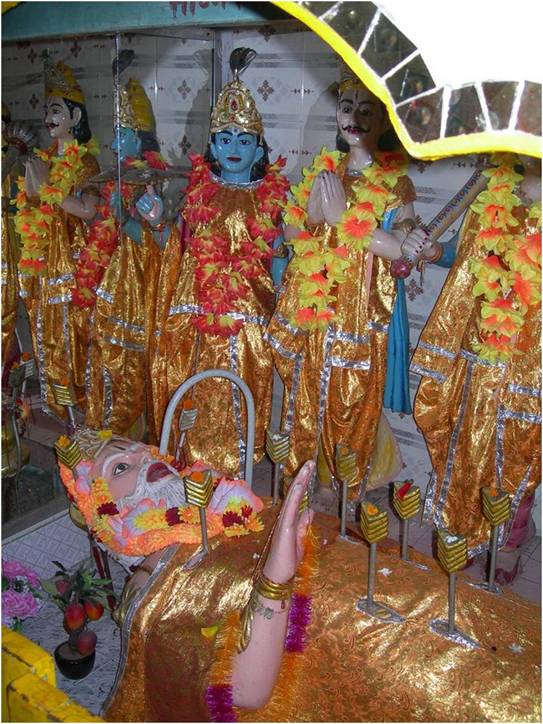
Bhisma kunda is situated in Narkatari area of Kurukshetra close to the highway connecting Jyotisar and Brahma sarovar. This is the place where the great grandsire of Kuru dynasty, Bhismadeva, was shot down by Arjuna in a volley of arrows with Shikhandi in front of him and Bhisma refusing to fight. Bhismadeva was down and lying on a bed of arrows called ‘sharashayya’, waiting for his death at the most auspicious time called Uttarayana. When he asked Arjuna to quench his thirst, Arjuna knew that the great Bhishma did not thirst for water of this world. So Arjuna pierced the earth with an arrow, and Ganges water gushed out like a fountain. Bhishma drank the holy water and thanked Arjuna for his great deed. There is a beautiful deity of Bhishma portraying this pastime.
After the battle got over, following the advice of Lord Sri Krishna, all the Pandavas headed by Yudhisthira Maharaj arrived at this spot where he learned the science of Raja-dharma.
Pilgrims to Ban Ganga can also see a Deity of Lord Krishna in His universal form and a 26-foot-high deity of Hanuman here.
Ban Ganga (Dayalpur)
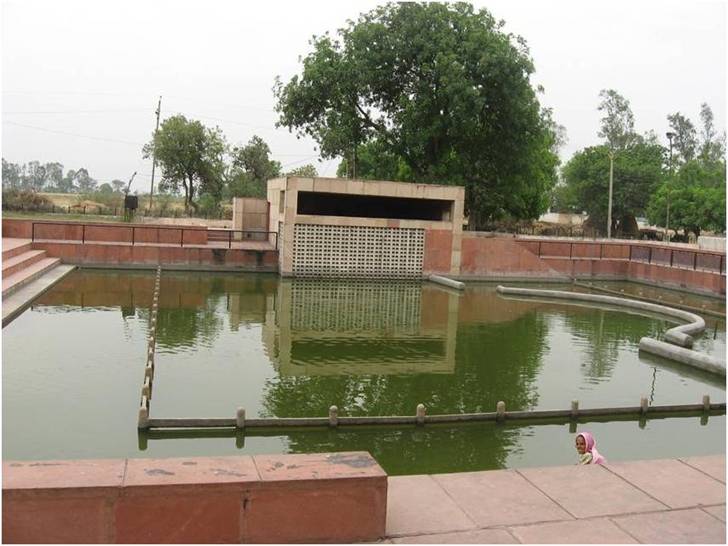
This is a small village a couple of miles from Brahma Sarovar. Here Arjuna also brought forth the Ganges by shooting an arrow into the ground, this time to provide drinking water for his chariot horses during his single combat with Jayadratha.
Karnavadha
Karnavadha is a long trench where the wheels of Karna’s chariot were stuck before Arjuna killed him. It is in Kheri Markanda part area.
Sthaneshwar Mahadev Temple
This Place is very ancient pre dating Mahabharata battle. Here, Pandavas prayed to Lord Shiva to receive his blessings for the victory in the battle of Mahabharata. So, the water of the tank adjoining the temple is believed to be holy and ancient. Locals say Kurukshetra pilgrimage visit is incomplete without visiting this temple of Kshetrapal (Protector of holy land). Sthaneshwara Mahadev Temple is situated at Thanesar area in Kurukshetra city.
BHADRAKALI Temple
Bhadrakali Temple is situated on the Jhansa Road in the town of Thanesar in the district of Kurukshetra. It is said to be one of the 51 Shakti peeths connected with pastime of Sati Devi, consort of Lord Shiva. Her Ankle fell here and since then its worshipable place.
Ekhans (Dhundu) Tirth / Parasar/ Dwayapayana
Parashar Muni, the father of Srila Vyasadeva, had his ashram here, about 102 kilometres south of the Brahma sarovar. Duryodhana hid in the lake here after running away from battle at the end of the Mahabharata war. He came out of the water when the Pandavas challenged him to fight. The lake in which Duryodhana hid himself right after the culmination of the war is located in the state of Haryana in India. Originally called 'Ek Hans', Ikas is an alias of the old name. The place is also called 'Dhundu Johar' because Duryodhana hid himself here during the battle of Mahabharata. It was here where Yudhishthira along with the other Pandavas located him and he was killed at the hands of the mighty Bhima.
Prithudak Tirth in Pehowa
Pehowa, 24 kms west of Brahma sarovar, was formerly known as Prithudak, “the pool of Prithu.” King Prithu, an incarnation of Lord Krishna’s ruling potency, performed last rites for his father here. Hundreds of pilgrims visit Pehowa every day to offer oblations to their ancestors. Those who died on battle of Kurukshetra were also given last rites here. Here River Saraswati river flows thru the ancient temple of Prithudak.
Chakravyuha
At Chakravyuha, eight kilometers south of Thaneswar, the general Dronacharya organized his army in the shape of a discus (chakra). It is also where Abhimanyu, the son of Arjuna and Subhadra, was killed.
Sri Krishna Arjuna Temple, ISKCON Kururkshetra
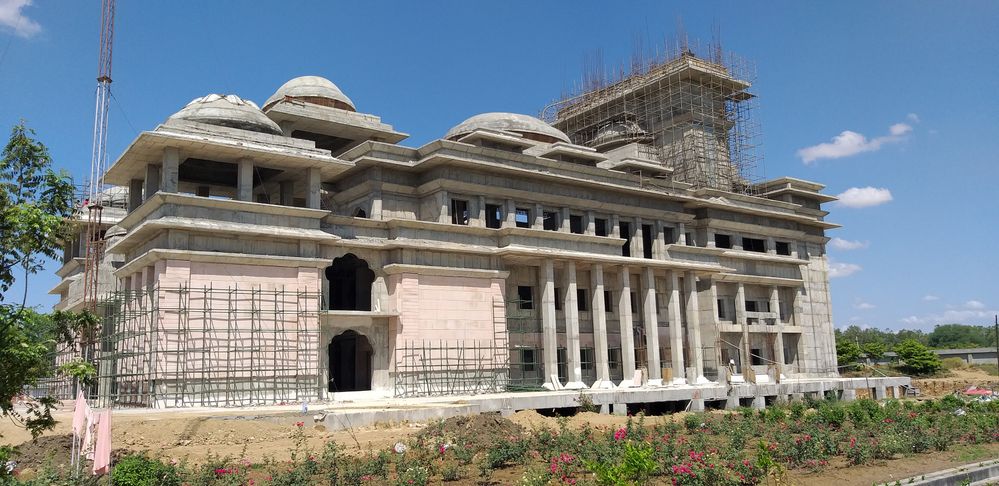
This ISKCON temple is very next to “Jyotisar”, the exact spot where Lord Sri Krishna spoke Srimad Bhagavad-Gita. It was Srila Prabhupada’s strong desire that there be ISKCON Temple next to Jyotisar. The presiding Deities are Their Lordships Sri Sri Jagannatha-Baladeva-Subhadra & Sri Sri Nitai-Gauranga Mahaprabhu. This temple has a garden with variety of beautiful roses for the pleasure of Their Lordships. Temple also has a Goshala. A big temple is under construction. ISKCON (International Society for Krishna Consciousness) has 2 Temples in Kurukshetra: (1) Sri Krishna-Arjuna Jyotisar Temple, (2) Sri Sri Radha-Radha Kant Temple, Main Bazaar
Srila Prabhupada at Kurukshetra
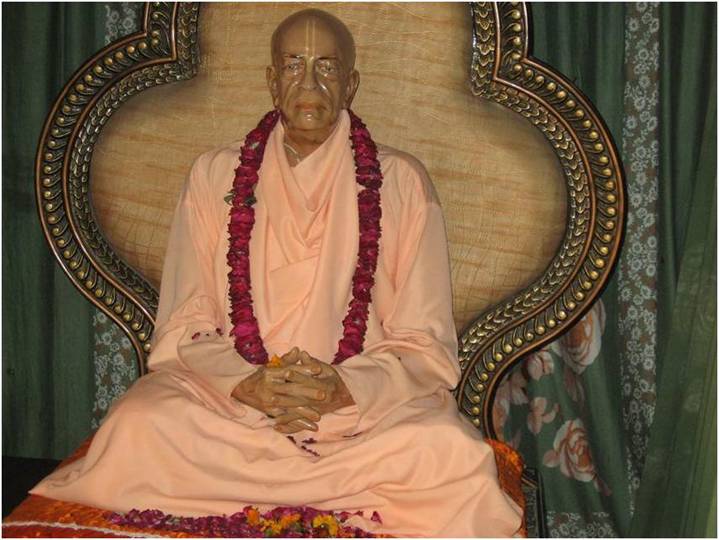
In October 1970, Srila Prabhupada was traveling to Amritsar by train with a group of disciples. As the train arrived in Kurukshetra station, he said, “Just here, Lord Krishna spoke Bhagavad-Gita five thousand years ago. People say that it does not exist, that it’s a mythological place, a symbol of the field of the body and the senses. They say it is an allegorical place. But here we are at the Kurukshetra station.” As he spoke, the sun was setting, and a bright orange sky shone over the flat land. “How can they say Kurukshetra is not a real place?” he continued. “Here it is before us, and it has been a historical place for a long, long time.”
On December 1, 1975, Srila Prabhupada went to Kurukshetra with several disciples. Before returning to Delhi, he decided to visit a less developed area of Kurukshetra called Jyotisar, the actual place where Lord Krishna had spoken the Bhagavad-Gita. Srila Prabhupada walked about and thoroughly inspected the area. After ten minutes he asked the devotees what they thought of it. Everyone expressed enthusiasm about the place, which they sensed as spiritually vibrant. A deep, timeless wisdom and serenity seemed to permeate the atmosphere. Srila Prabhupada told the devotees that ISKCON should build a temple of Krishna and Arjuna there.
In 1996, the Srila Prabhupada Centennial year, devotees made a special effort to obtain a parcel of land in Jyotisar. By the grace of Krishna and Arjuna they succeeded in acquiring six acres, just a hundred yards away from the spot where the Bhagavad-Gita was spoken. In April 1998, the governor of Haryana presided over the ceremony dedicating the ground for the temple. A magnificent temple is under construction today.
Also during the Srila Prabhupada Centennial year, a prominent square in the town of Kurukshetra was named after Srila Prabhupada: Bhaktivedanta Swami Chowk [Square].